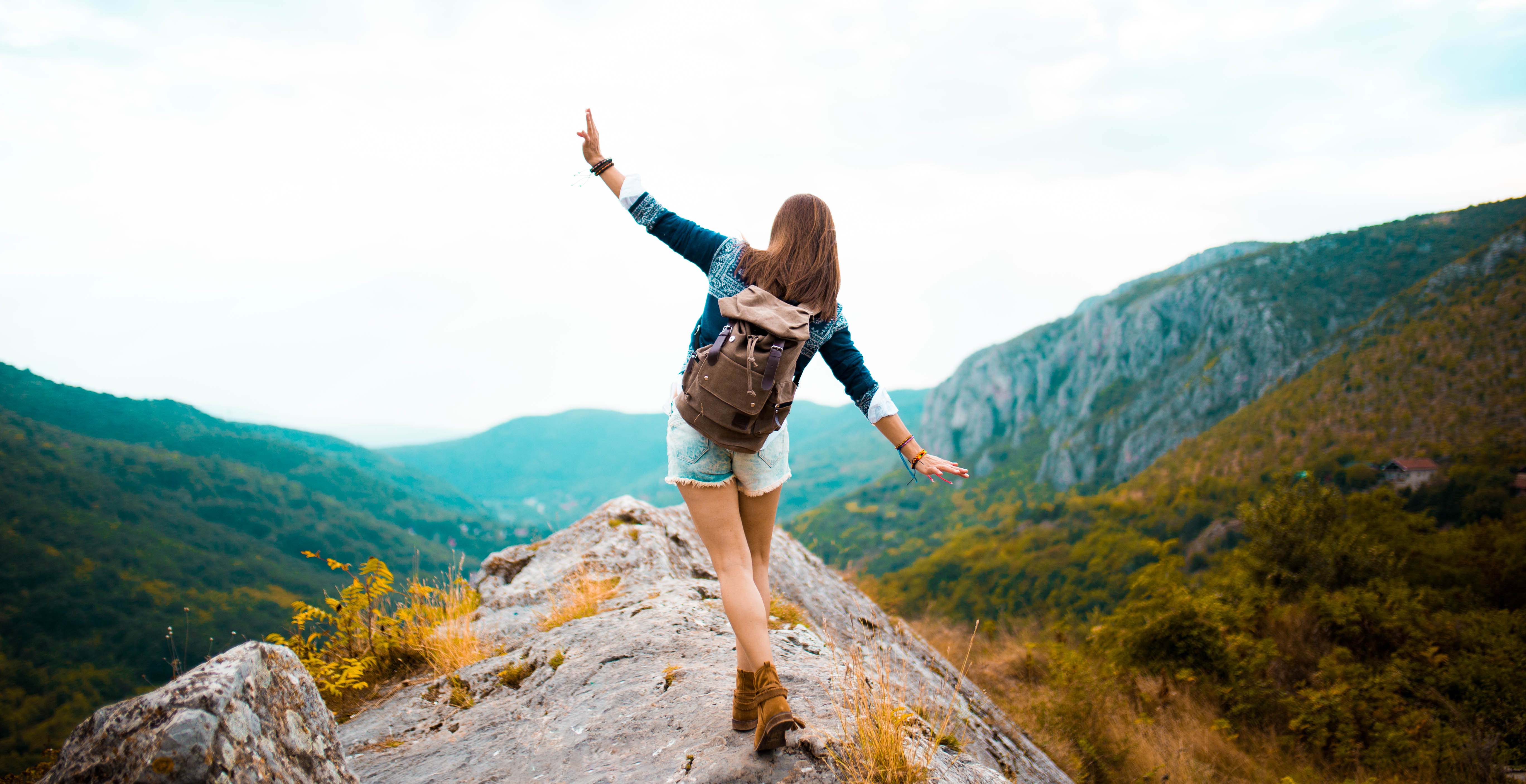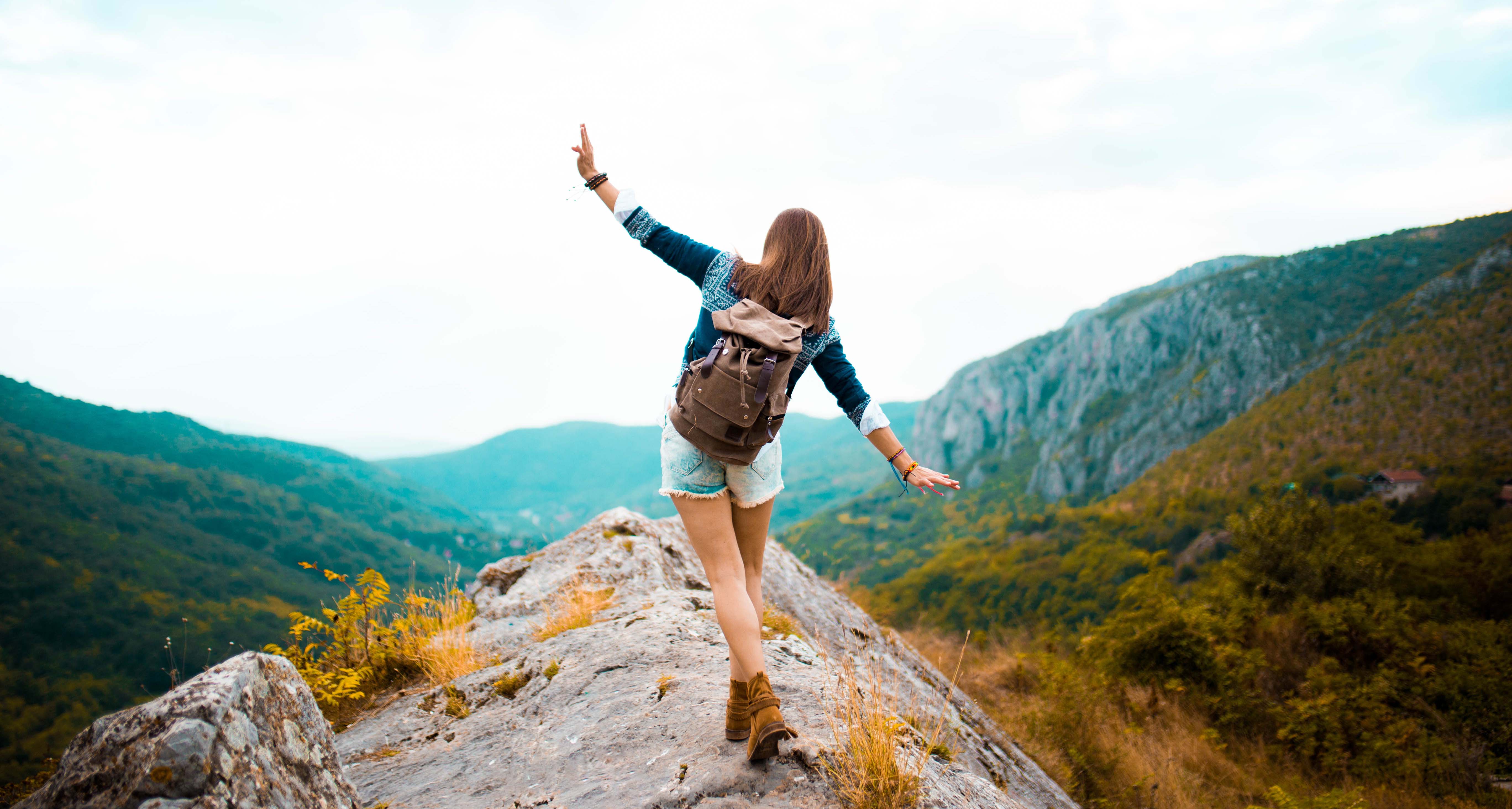Ready, Set...Hike


Even if you don't reach the summit, with its beautiful views, the breathtaking photos you’ll be able to share with friends and the joy of spending time surrounded by nature, still make hiking a winning proposition. It’s got all the health benefits of walking, the muscle toning you’d get from an intense session on the StairMaster and — when you feel like throwing in the towel — that unstoppable urge to get to the top of the mountain.
Work out your whole body. Think of a trail as a real-world gym, and every rock and log you climb on or step over as the gym equipment. “You’re balancing on one leg, you’re working your quads and glutes, and doing lots of step-ups,” says Michael Wood, CSCS, chief fitness officer at the national fitness centre Koko FitClub. And it’s not just going to work your legs. “If you have poles, it’s working the shoulders, the arms and the back,” says Wood, who also blogs about fitness.
Lose weight and keep it off. Bree Gotsdiner, former public relations consultant at Fitpacking, a group that organizes backpacking trips to help people lose weight, was overweight years ago before she started regularly hiking as a firefighter for the U.S. Forest Service. “Not only did I lose fat, but I got healthy — it’s constant cardio and constant strength-building,” Gotsdiner says.
Burn calories. The average 180-pound person burns about 610 calories per hour when climbing hills with 10 to 20 pounds on his back, about the weight of your average car tire. You can sweat off some serious pounds, so long as you go easy on the trail mix.
Conquer peaks and find scenic vistas. Breathtaking views are out there: The challenge (and the fun) is getting there on your own. “You get to see things you can’t see from a car or anywhere else, because you have to be on foot to get there,” says Chris Szczech, a manager at the Colorado Trail Foundation Trekking Program, where his guided tours can reach elevations higher than 13,000 feet.
Find a trail for every workout. Your first hike doesn’t need to — and shouldn’t — be a six-hour climb to the highest summit in your area. Instead you can slowly build up intensity, either by walking shorter distances or finding less demanding trails. As you improve, you can add intensity by moving faster and hiking longer.
Escape stress. Can’t escape a flood of emails and work phone calls? Hiking, with its limited phone reception (or at least, that’s what you can tell everyone), is the perfect solution. “Hiking’s good for mental health because it gets people away from stresses from everyday life,” Gotsdiner says.
Learn the Lingo
Switchback: When the slope gets steep, the trail will turn nearly 180 degrees to “switch back” on itself. On a map, a series of switchbacks will look like zigzags.
Scramble: Hiking uneven, rocky terrain, sometimes requiring hands for stabilization.
Blazes: Visual markers (usually a combination of colours and shapes) found on trees, rocks and intersections that designate the route.
Cairn: A pile of stones that mark the trail, commonly found when there are no trees to mark with blazes.
Hot spot: An area on your foot that, left unaddressed, will likely become a blister. Friction from a poorly fitting boot is usually the cause.
Day hike: A hike that doesn’t involve an overnight stay in a tent. The big benefit of having less gear is that you can move swiftly and conquer more ground.
Backpacking: It's like hiking, but with the addition of carrying the food and gear you'll need for multiple nights of camping.
10 essentials:
The 10 basics you probably shouldn’t hike without: water, rain gear, first aid kit, extra food, compass, map, knife, fire-starter or matches, flashlight, and sun protection.
At its most basic level, hiking requires nothing more than a trail. But as you travel longer distances, increase elevation and put additional distance between yourself and civilization, you’ll need to improve your gear, fitness level and preparation to stay safe and get the most out of your hike. Our experts offer a few tips to keep you on the right path.
The Gear
Invest in boots. You can probably avoid heavy-duty hiking boots, which are designed to support the weight of a heavy backpack rather than the daypack you’ll be carrying. The beefiest of boots can weigh more than 3 pounds, compared to 1 to 2 pounds for a low-cut lightweight boot. “The extra weight on the foot is like carrying several pounds on your back,” Szczech says.
Buy the right socks. Try finding a pair of wicking socks designed specifically for hiking, which will provide extra padding in blister problem areas. A favourite brand of Szczech's is SmartWool.
Plan for the weather. If rain or chilly temperatures are possible, Szczech cautions not to chance it with cheap, low-quality outerwear.
Add poles to your hike. Poles can be a bit pricey, but they let you use your upper arms and offer added balance on steep climbs and descents, Szczech says.
Track your steps with a pedometer. It’s a simple way to measure your progress and to know when to turn around. About $30 will get you a basic model.
Don’t splurge on gadgets. It’s easy to drop $300 on a GPS unit and other pricey electronics, but Szczech says you’d probably be better off investing that money in high-quality gear and learning to use a map and compass. Where’s the satisfaction in exploring the wilderness with a GPS barking orders at you? All that technology can get distracting. “You might spend all the time doing what you were trying to get away from,” Szczech says.
The Preparation
Research local trails. The Internet has made finding nearby trails a breeze, but spending a few bucks on a hiking book can be worth the money (remember, books don’t require an Internet connection). Hiking associations and local clubs are also a valuable resource.
Break in those boots. The trailhead is not where you want to be putting on new boots for the first time, for obvious reasons. “If you get a blister in the first hour, it’s going to make the rest of your day horrible,” Gotsdiner says. Lose that new-boot stiffness by wearing them during errands.
Hike with others. Not only will buddying up make it harder to blow off the hike, but it’s also far safer. “If you hike for 5 kilometers and break your ankle, you're kind of screwed,” Wood says.
Tell someone your plans. If the unexpected happens and no one knows you’re in trouble, rescue crews won’t know you need rescuing. Szczech says to tell someone your planned route and hike duration before you leave.
Get help. If you’re feeling lost, a professional outfitter or guide will know the best trails in the area, can help you navigate them and may even offer shopping advice, Szczech says. As an alternative, ask a friend or coworker who has hiking or backpacking experience.
On the Trail
Take baby steps. When starting out, Szczech recommends staying in your comfort zone. “Someone used to walking 6 kilometers on a treadmill will try a 6-kilometer hike on a mountain and find it’s a whole lot different,” Szczech says.
Keep food and water flowing. Don’t wait until you’re parched to have a drink. Sipping water and eating a few small snacks during your hike will keep you hydrated and prevent your blood sugar from dropping, Szczech says.
Take plenty of breaks. If you’re tired, rest. Stopping for a few minutes will give you time to catch your breath and enjoy the scenery, and can also help you avoid overexerting yourself, Gotsdiner says.
Pay attention. “I see people all the time — they forget to look around, and that’s how people get lost, miss trail intersections,” Szczech says. “It’s also how you twist your ankle because you didn’t realize the trail got loose and rocky.”
Mind Mother Nature. Thunderstorms, wind and rain can creep up on you in an instant, so Szczech recommends planning ahead by checking the weather reports and keeping an eye on the sky. “People forget sometimes that our normal civilization has so much safety and comfort,” he says. “All that drops away in the woods, so you have to be prepared to make up for it somehow.”
Nature Dos and Don’ts
Respect the route. Trails don’t appear out of thin air; building and maintaining them require huge amounts of resources and volunteer time. Keep them in good shape by staying on the designated path.
Leave no trace. Everyone knows you shouldn’t litter. What people don’t often think about are the little things, such as tiny bits of foil from the edge of an energy bar and — though it’s a bit gross — toilet paper you’ve used while hiking. “We teach a pack-it-in, pack-it-out philosophy,” Szczech says.
By itself, hiking can get your whole body into great shape, but it’s not a bad idea to incorporate a few training exercises on your days off. A good thing to keep in mind while you’re working out is to keep your workout moves just as dynamic and variable as hiking is in the real world.
Workout 1: Get on the Right Path
Time: 30 minutes
After completing a successful 12-day summit of Mount Kilimanjaro in Africa, Wood learned the type of training that’s required to get ready for a major hike. To succeed on the trail, Wood, who’s 50, stresses building core strength, flexibility and leg strength. During his time at the gym, he focuses on dynamic workouts with lots of movement and a large range of motion, but it is actually yoga that has been his most important activity to avoid injury and improve flexibility.
Workout 2: Hit the Treadmill
Time: 30 minutes
Strapping on a 15-pound daypack, lacing up your hiking boots and hopping on a treadmill or StairMaster for an hour may attract some odd glances, but that’s one way Szczech maintains his hiking form when it’s difficult to hike outside. “Exercise in your gear, because then you’ll get comfortable,” he says. There are also a number of exercises that will hit the muscles you’ll need to perform on the trail.
